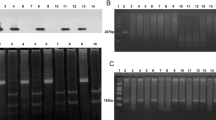Abstract
The transcription of human endogenous retrovirus E (HERV-E) clone 4-1 was determined in peripheral blood mononuclear cells (PBMC) of patients with systemic lupus erythematosus (SLE). However, the contribution of HERV-E clone 4-1 expression in the development of SLE remains unclear. Blood plasma and PBMC from 55 patients with SLE and a control group of 35 healthy individuals were collected. Blood plasma concentration of five antinuclear antibodies including anti-U1 ribonucleoprotein (RNP), anti-Sm, anti-Scl-70, anti-single-stranded DNA (ssDNA), and anti-double-stranded DNA (dsDNA) was analyzed by enzyme-linked immunosorbent assay (ELISA). Total RNA was isolated from PBMC and reverse transcribed into cDNA. The number of copies of HERV-E clone 4-1 gag transcript in PBMC was determined by real-time quantitative polymerase chain reaction (RQ-PCR) analysis. Spearman statistical analysis indicated that blood plasma concentrations of anti-U1 RNP and anti-Sm antibodies may correlate with PBMC transcript levels of HERV-E clone 4-1 gag sequence (R=0.775, p<0.000001; R=0.698, p<0.000001, respectively). Our observations suggest that the expression of HERV-E clone 4-1 might be associated with production of anti-U1 RNP and anti-Sm antibodies in patients with SLE.

Similar content being viewed by others
References
Sekigawa I, Naito T, Hira K et al (2004) Possible mechanisms of gender bias in SLE: a new hypothesis involving a comparison of SLE with atopy. Lupus 13:217–222
Stohl W, Metyas S, Tan SM, Cheema GS et al (2003) B lymphocyte stimulator overexpression in patients with systemic lupus erythematosus: longitudinal observations. Arthritis Rheum 48:3475–3486
Quigg RJ (2004) Complement and autoimmune glomerular diseases. Curr Dir Autoimmun 7:165–180
Pirner K, Rascu A, Nurnberg W et al (1994) Evidence for direct anti-heparin-sulphate reactivity in sera of SLE patients. Rheumatol Int 14:169–174
Nakajima M, Nakajima A, Kayagaki N et al (1997) Expression of Fas ligand and its receptor in cutaneous lupus: implication in tissue injury. Clin Immunol Immunopathol 83:223–229
Rosen A, Casciola-Rosen L, Ahearn J (1995) Novel packages of viral and self-antigens are generated during apoptosis. J Exp Med 181:1557–1561
Zeng FQ, Yin RF, Tan GZ et al (2004) Characterization of DNA antigens from immune complexes deposited in the skin of patients with systemic lupus erythematosus. Chin Med J 117:1066–1071
Fillit H, Shibata S, Sasaki T et al (1993) Autoantibodies to the protein core of vascular basement membrane heparan sulfate proteoglycan in systemic lupus erythematosus. Autoimmunity 14:243–249
Greidinger EL, Foecking MF, Schafermeyer KR et al (2002) T cell immunity in connective tissue disease patients targets the RNA binding domain of the U1-70 kDa small nuclear ribonucleoprotein. J Immunol 169:3429–3437
Hishikawa T, Ogasawara H, Kaneko H et al (1997) Detection of antibodies to a recombinant gag protein derived from human endogenous retrovirus clone 4-1 in autoimmune diseases. Viral Immunol 10:137–147
Leib-Mosch C, Brack-Werner R, Werner T et al (1990) Endogenous retroviral elements in human DNA. Cancer Res 50:5636–5642
Talal N, Garry RF, Schur PH et al (1990) A conserved idiotype and antibodies to retroviral proteins in systemic lupus erythematosus. J Clin Invest 85:1866–1871
Ogasawara H, Naito T, Kaneko H et al (2001) Quantitative analyses of messenger RNA of human endogenous retrovirus in patients with systemic lupus erythematosus. J Rheumatol 28:533–538
Urnovitz HB, Murphy WH et al (1996) Human endogenous retroviruses: nature, occurrence, and clinical implications in human disease. Clin Microbiol Rev 9:72–99
Tan EM, Cohen AS, Fries JF et al (1982) The 1982 revised criteria for the classification of systemic lupus erythematosus. Arthritis Rheum 25:1271–1277
Bombardier C, Gladman DD, Urowitz MB et al (1992) Derivation of the SLEDAI. A disease activity index for lupus patients. The Committee on Prognosis Studies in SLE. Arthritis Rheum 35:630–640
Weller TH, Coons AH et al (1954) Fluorescent antibody studies with agents of varicella and herpes zoster propagated in vitro. Proc Soc Exp Biol Med 86:789–794
Koshino K, Tokano Y, Hishikawa T et al (1995) Detection of antibodies to HIV-1 gp41 and HLA class II antigen-derived peptides in SLE patients. Scand J Rheumatol 24:288–292
Zack JA, Arrigo SJ, Weitsman SR et al (1990) HIV-1 entry into quiescent primary lymphocytes: molecular analysis reveals a labile, latent viral structure. Cell 20:213–222
Naito T, Ogasawara H, Kaneko H et al (2003) Immune abnormalities induced by human endogenous retroviral peptides: with reference to the pathogenesis of systemic lupus erythematosus. J Clin Immunol 23:371–376
Douvas A, Takehana Y et al (1994) Cross-reactivity between autoimmune anti-U1 snRNP antibodies and neutralizing epitopes of HIV-1 gp120/41. AIDS Res Hum Retroviruses 10:253–262
Haustein UF, Pustowoit B, Krusche U et al (1993) Antibodies to retrovirus proteins in scleroderma. Acta Derm Venereol 73:116–118
Hishikawa T, Ogasawara H, Kaneko H et al (1997) Detection of antibodies to a recombinant gag protein derived from human endogenous retrovirus clone 4-1 in autoimmune diseases. Viral Immunol 10:137–147
Perl A (2001) Endogenous retroviruses in pathogenesis of autoimmunity. J Rheumatol 28:461–464
Bessis D, Moles JP, Basset-Seguin N et al (2004) Differential expression of a human endogenous retrovirus E transmembrane envelope glycoprotein in normal, psoriatic and atopic dermatitis human skin. Br J Dermatol 151:737–745
Villesen P, Aagaard L, Wiuf C et al (2004) Identification of endogenous retroviral reading frames in the human genome. Retrovirology 1:32–45
Acknowledgments
Supported by a Grant No. 2PO5B01927 from the State Committee for Scientific Research (KBN). We would like to acknowledge J Prokop, MD, PhD and A. Osmola, MD from the Department of Dermatology of Karol Marcinkowski University of Medical Sciences, Poznań, for providing SLE patients.
Author information
Authors and Affiliations
Corresponding author
Rights and permissions
About this article
Cite this article
Piotrowski, P.C., Duriagin, S. & Jagodzinski, P.P. Expression of human endogenous retrovirus clone 4-1 may correlate with blood plasma concentration of anti-U1 RNP and anti-Sm nuclear antibodies. Clin Rheumatol 24, 620–624 (2005). https://doi.org/10.1007/s10067-005-1123-8
Received:
Revised:
Accepted:
Published:
Issue Date:
DOI: https://doi.org/10.1007/s10067-005-1123-8




